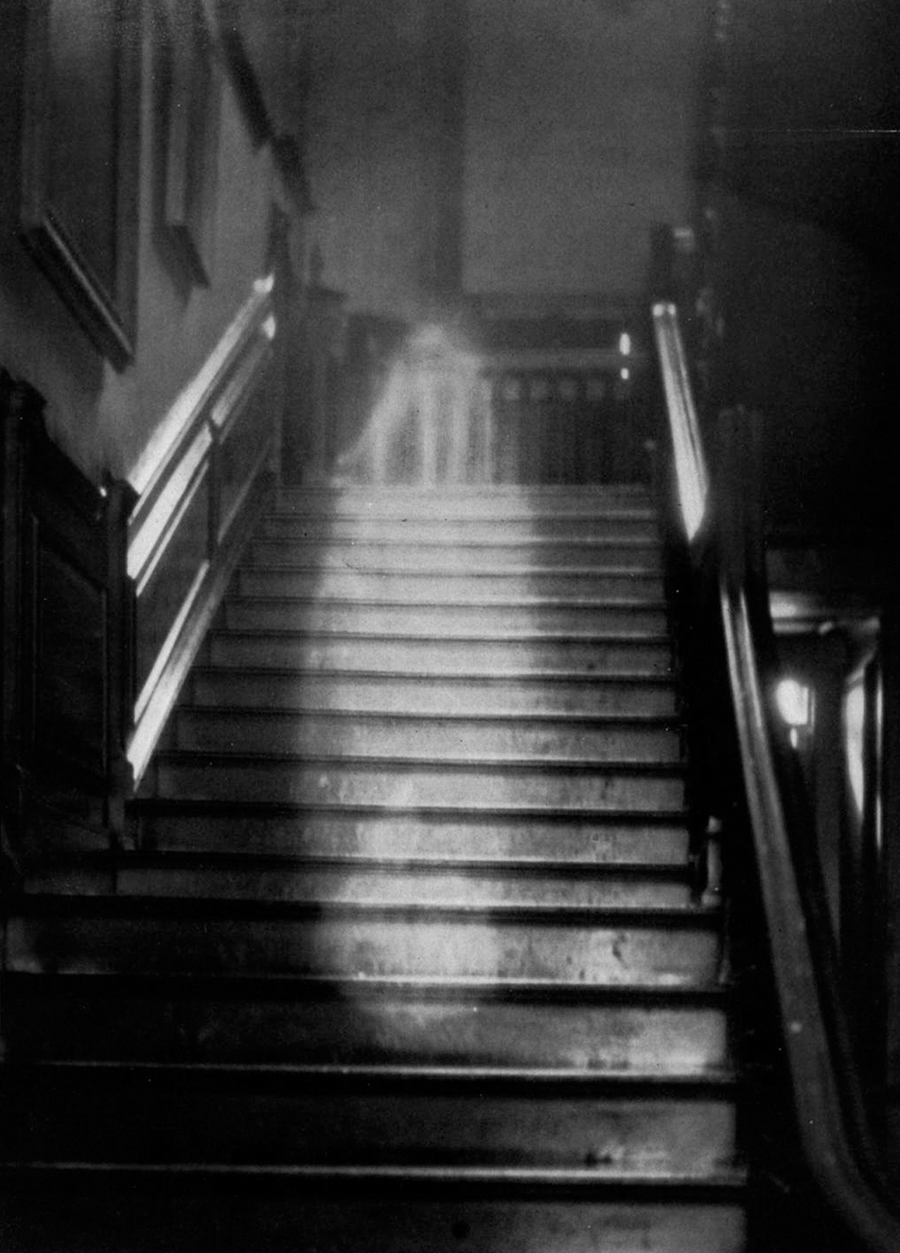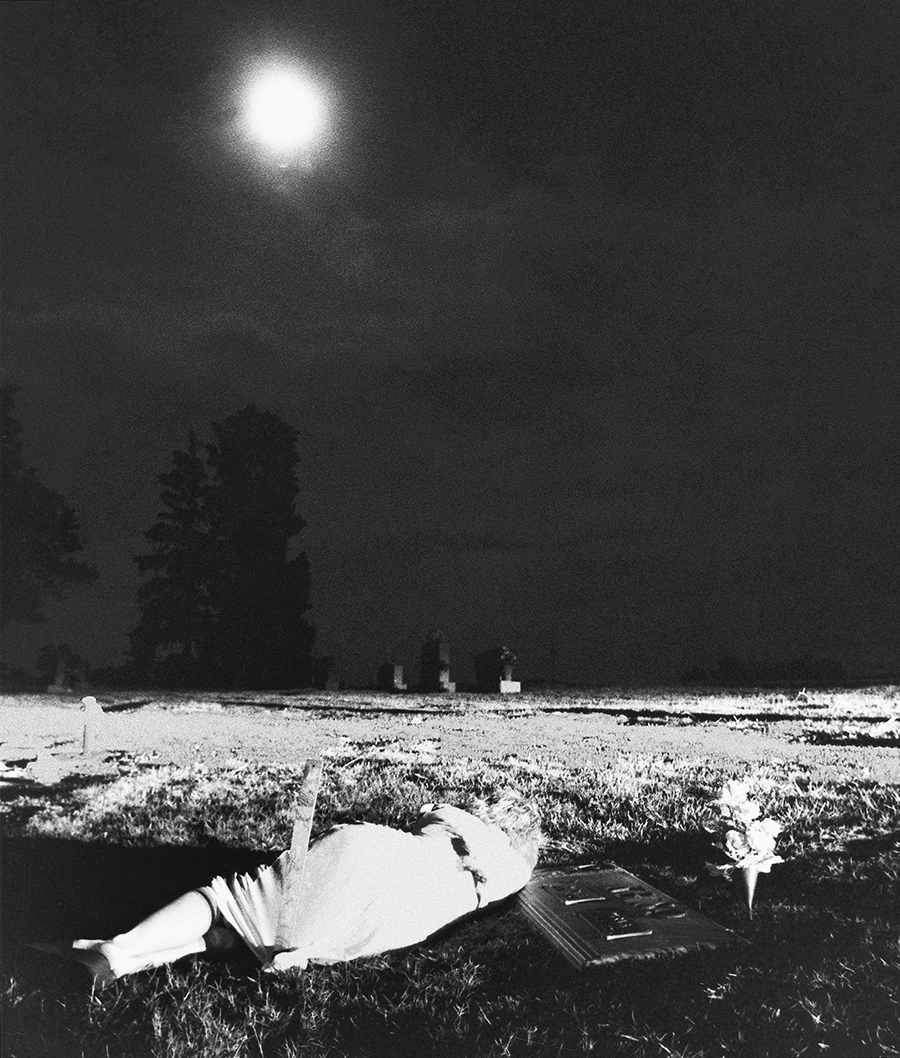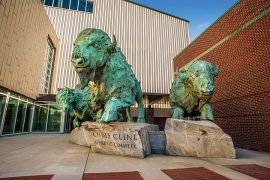In Part 1 of a series, HQ explores some of the region’s most infamous tales of ghoulish ghosts and haunted houses …
By Joseph Platania
HQ 36 | AUTUMN 1999
Fifth Street Road is one of the major thoroughfares leading south out of Huntington. The three-lane blacktop road makes a long, steep climb up Fifth Street Hill from its base at the stone bridge across Fourpole Creek to its crest at a cut through the hill. From there the road has a gentle descent to the I-64 interchange and then into Wayne County. For more than 50 years, there has been a story in circulation that late at night when it is raining, a young woman stands at the top of the hill and thumbs a ride from passing motorists. Since her appearance usually occurs after midnight and because it is raining, she always gets a ride. After several minutes inside the car, she
vanishes into thin air.
The first account of this ghostly tale was published in a Huntington newspaper on October 30, 1942. The article states that a few days earlier, a Black & White Cab driver left off his fare at a dance hall on Fifth Street Road early in the morning at about 4:30 a.m. and started back toward Huntington. It was then that he encountered “the mysteriously vanishing hitchhiker.” The cab driver told his story as follows:
“When I got to the top of Fifth Street Hill, a girl hailed me from the roadside. I stopped, opened the door, and she got into the rear seat. It was pretty cold, but she did not have any coat or hat on, just a skirt and thin blouse. I thought that was funny and said: ‘It’s pretty cold without a coat, isn’t it?’ And she replied: ‘I haven’t worn a coat for nine or ten years.’ I asked the girl where she was going and she told me to let her off at the bottom of the hill. I drove down the hill about 20 or 25 miles an hour, stopped at the house, and turned around to collect my fare and let the girl out. She was not sitting in the seat. I thought maybe she had fainted or something and fell off the seat, so I looked down on the floor. But there was nobody there. I looked back up the road and couldn’t see anybody, so I drove back to the taxi headquarters. I said to the dispatcher, ‘I’ve just been gypped out of a quarter,’ and I told him what had happened. He said he had heard of that same thing happening to a Yellow Cab driver about a year before in the same place, and called up the Yellow Cab office and asked them about it. They said it happened to one of their drivers.”
The reporter located a relative of the Yellow Cab driver who confirmed that his cousin had told him about an almost identical experience a year earlier when they both were working for the Yellow Cab Co. The article adds that the mysterious rider who disappears after the cab has reached its destination “has been dubbed by cab drivers, ‘The Ghost Girl of Fifth Street Hill.'”
Sixteen years later, a November 1958 newspaper story about the ghost states that “she never says a word and she always disappears from the car like a puff of smoke when it reaches the stoplight at the bridge.” According to the article, the story behind the apparition goes as follows:
“Quite a few years ago, a Huntington couple took their daughter and her fiancée to Wayne to be married. It was in the early spring, just the season for marriages, and the wedding went off without a hitch. However, on their way back, rain started coming down in a slow drizzle, the kind that makes roads slick. At the foot of the hill, just before coming to the bridge at the corner of Fifth Street and the boulevard, the car overturned and the bride was killed. Ever since then, but especially in the early spring and only when it’s raining, the bride reappears on the hill. Standing at the top and wearing her white dress, she thumbs a ride from passing motorists.”
The article adds that this story was told to the reporter by a friend who was told the tale by a cab driver who got it from a friend of his who heard it from a local minister “who swore the girl was real and has seen her.”
It adds that the bride disappears at the bridge because that was as far as she was originally going.

The article reports that “one man tried to ignore the bride a couple of years ago, but she was not to be brushed aside. It adds that “suddenly his car engine quit, the lights went out and the radio stopped. When he got out to investigate, the bride ran back down the hill. As she did this, he was startled to hear his car running, lights burning, and the radio playing.” The story says, “since its first sighting, the hitchhiker has been reported hundreds of times.”
In a 1977 folklore taped by a Marshall University student for a class in Appalachian literature, John Fields, a retired Milton resident, relates another version of this ghost story:
“A cab driver came along somewhere out on Fifth Street Hill and this woman dressed in a wedding gown with no coat on flagged him down. He said ‘Where to?’ and she gave him an address somewhere in West Huntington. He said to her “Aren’t you cold out this cold night with no coat on? And she said to him, ‘I don’t get cold.” And he drove down there and parked at the number she had given him and he looked back to let her out and nobody was there. Well, he got his hair all raised up so he knocked at the door and an old lady came to the door. And he says, “Lady, I’ve had a terrible experience that I can’t figure out.’ And he told her what had happened. She said ‘That’s my daughter.’ She said that she died. She added ‘she comes back every four years.’ He got out of there and quit his job.”
Bob Cook, office manager for Taxi Service, Inc., the operator of Yellow Cabs in Huntington, and a former cab driver himself, states that he hasn’t heard anything about the Fifth Street Hill ghost for about a dozen years.
The story was often repeated years ago, says Cook, adding that drivers of “consolidated buses” (Greyhound and Trailways) also reported picking up the young woman along Fifth Street Hill. They told a similar story that she would board their bus and then when it stopped at her destination, she had disappeared.
Despite the legend’s longevity, some of the newer cab drivers had never heard of the Fifth Street Hill ghost.
Has the hitchhiking wraith thumbed her last ride, boarded her last bus or ridden in her last taxicab? A social and cultural history titled We Americans states that “no legend enjoys wider circulation in the United States than the account of the vanishing hitchhiker.” In fact, the story has been traced back to the days of horse-drawn vehicles. It adds that almost without exception, the story takes place in a specific location and the hitchhiker is a young woman.
Karen Sewell, of Huntington, tells a story about her husband’s grandmother who was Mrs. Nona Nicely. Ms. Sewell says that during the late 1890s or early 1900s, when Mrs. Nicely was a young married woman, she and her husband rented a house in Milton, W.Va. Every morning when Mrs. Nicely went into the dining room, the ends of the tablecloth would be turned up in the middle of the table. After this went on for some time, one night Mrs. Nicely decided to stay awake to see what was going on in her home. Eventually Mrs. Nicely dozed off and when she awoke, the ends of the tablecloth again were turned up in the middle of the table.
After inquiring about the house’s past, she was told that a man had been murdered there and his body had been carried out in a tablecloth. Soon thereafter, the young married couple moved out of the house.
Perhaps the earliest published local account of the supernatural is contained in the Huntington Advertiser for September 23, 1905 in an article titled “Guyandotte Inhabited by Ghost.” At the time, Guyandotte, then nearly a century old, was a sleepy little river town located two to three miles east of Huntington.
The article reports that for the past few nights, Guyandotte residents “have been considerably worked up over the persistent and mysterious appearance of a ghost dressed in the black habit of a woman in mourning.”
The story states that the ghost “frequents North Bridge and Short Streets where the shade is the thickest and the gloom and stillness give to the surroundings the appearance of a most desirable stop … selected by goblins and spirits to prowl.”
The ghost is described as having “the appearance of a woman dressed in the deepest shade of black,” and when pedestrians are passing along the above named streets, she walks up behind and keeps pace with them whether they walk fast or slow or, if they stop, she also will stop. It adds that the spirit continues this pace until the pedestrians reach better-lighted streets when she disappears. Most Guyandotte women avoided the area after several had encountered “the mysterious personage.”
Several nights before, as a man was on his way home and was walking along one of the haunted streets, “the lady in black approached him from behind,” says the story. It adds that the man thought it was someone wishing for him to stop, so he waited for her, but when she got close to him she also stopped. He tried to speak to her but she did not utter a word and kept her distance from him. He then resumed walking with the ghost following behind him. He walked faster and she followed. Then he stopped and so did she. At about this time, he began to get cold chills up his back and he tried to think of a way to escape from the apparition but it was useless. Finally he started to run for home and looking back, he found the woman pursuer close behind him. When he arrived within a block of his home, “the report goes that the neighbors were awakened by the loud yells in a masculine voice calling to his wife to open the door for him.”
Whether the ghost of “the lady in black” ever reappeared to stalk desolate Guyandotte streets is not known. A paranormal experience may involve a commonplace object such as a weathered old suitcase, the kind you might find stored in an attic. But be careful when you open the case, it may contain more than old memories.
Huntington-area resident Homer W. Van Scoy and his family found that out in an experience that he recounted in an article for the October 1978 Columbus Dispatch.
In the article, Van Scoy, who was a carpenter by trade, states that he had remodeled an old Victorian house located on Huntington’s Sixth Street into an office. The house had 12 rooms and four dormers and was packed with artifacts from the 19th Century. He adds that after the remodeling, everything was hauled off to the city landfill except an old black suitcase which he took back to his home and placed in an upstairs bedroom where it was forgotten until several months had passed. Van Scoy writes that it was then that his 20 year old son, Harold, awakened the family at two in the morning exclaiming: “There’s a woman in my room. She’s got long black hair and the strangest clothes. She was talking to me but I can’t remember what she said.”
Van Scoy says that he and his son then searched the house but couldn’t find any trace of a woman who fit that description. Van Scoy adds that no further disturbance occurred in his home until the Saturday before the Fourth of July when their children and grandchildren were visiting. It was then that his daughter exclaimed: “Daddy, there’s a man with a heavy black beard looking through the window,” writes Van Scoy. He adds that he peered over the top of the television into the darkness and there was a black-bearded face staring back at him. However, a dash outside into the night in search of the bearded man proved fruitless.
Van Scoy states that early one morning in October, he was preparing to leave for a class at the university when he rushed upstairs to retrieve a letter he wanted to mail. He adds that he saw a man standing by the four-poster bed. He was young, maybe 26, and wearing clothes that were suitable for the late 1800s. The young man had large sideburns but no whiskers. Van Scoy writes: “We faced one another for a few seconds, then he disappeared upward into the ceiling.”

It was then that Van Scoy says he spotted the old black suitcase that had been stored in the bedroom for several months. After he returned from class, Van Scoy gathered his family around the table and they opened the suitcase. It contained letters and cards similar to the ones they had seen at the remodeling job on Sixth Street. The case also contained several old photographs. One was of a farm with a barn and blacksmith shop and surrounded by low rolling hills. The farmhouse had wooden shingles, tiny porches and a summer kitchen. There also were flower gardens framed by a white picket fence.
He adds that the other photograph was of a prosperous-looking farm family enjoying an afternoon of music and singing. The family consisted of a father, mother, two sons and two grandchildren adding that the photos were dated June 10, 1886.
Van Scoy states that his son recognized the mother in the photograph as the woman he saw bending over his bed that night. He adds that the black-bearded man and the young man in his mid-20s also were recognized in the photo.
Van Scoy writes that his wife said: “Well, we’ve seen half of them but the whole family is here and they’re trying to tell us something.” Van Scoy adds that his son offered a solution: “Find that farm house and take the suitcase back and leave it there. That is probably what they want us to do,” says Van Scoy, quoting his son.
During that winter and the following spring, Van Scoy and his wife toured nearby farm counties in West Virginia and Ohio looking for the farm in the photograph. They also contacted real estate offices, insurance companies and city newspapers but without success. Then one evening in April, his daughter made an observation. “Daddy, have you ever noticed how much this house resembles that one in the photograph? And see how the streets come down into a little valley.”
The Van Scoy family gathered and quickly matched their home with the one in the 1886 photograph. They reached the conclusion that “we were actually living in the farm house for which we had been searching.” He adds that his wife suggested: “Why don’t we move out and let them have it? I don’t want to live here with all these people laughing and running through the rooms scaring the daylights out of everybody.” Van Scoy states that right after graduation, they bought a house in another neighborhood. He adds that they left nothing behind except “that old black suitcase,” which he says he hid in the attic.
The next story was told by a Huntington woman to her granddaughter who recorded it in 1985 for a class in Appalachian literature at Marshall University. The storyteller begins by stating:
“One evening four couples, reluctant to see the evening end, had started telling the latest gossip and gradually drifted into telling ghost stories. Finally, one member of the group suggested a plan to test their courage, since they all seemed skeptical as to whether or not they really believed in ghosts. They would go to the cemetery at the edge of town, and while the group waited at the gates, one member would enter the cemetery, go to a grave in the darkest part of the field, and drive a stake into the grave and then return to the waiting group.
“After what seemed hours, six of the group having completed the terrifying act, it was Mary Ann’s turn. Mary Ann was a shy girl who talked very little and always seemed to keep in the shadows. She felt she had to prove that she was not a coward so she took the stake and set out to prove she was as brave as any of the group.
“Minutes passed and Mary Ann still had not returned. Finally, the boy who had been her date for the evening announced loudly that he would go see if she had lost her way in the darkness. The others followed, huddled together, suddenly afraid.
“When they found her she was lying across a grave, not moving. When they tried to pick her up, it was discovered that she had driven the wooden stake through a fold of her dress and could not rise from the grave. Poor Mary Ann had died of fright certain in that terrible moment that some evil force had reached from the grave to punish her for her act of desecration …”





